Let’s talk about a weird nuance in the world of e-commerce SEO.
In e-commerce, there are big stores, and there are small stores. Stores with big catalogues (think REI) and stores with small catalogues (think SimpliSafe).
Just for the sake of a quick definition, let’s say:
- Small store = a store that sells 12 or fewer products
As a quick clarification, small stores can still be big businesses.
SimliSafe rakes in an estimated $100-$500 million in annual revenue. iRobot, who sells Roomba and about a dozen other vacuums and mops, earned over a billion dollars in 2020.
When it comes to SEO, big stores have a pretty distinct advantage: they inherently have lots of pages.
Big catalogs = lots of products = lots of pages = lots of keywords to target = much higher natural traffic potential.
When big stores start to grow, it often happens naturally over time. There’s still work to do, of course (big stores often have much more complex technical SEO problems, and all those product descriptions make for demanding content requirements, for example).
But getting off the runway is typically easier and more predictable. There are just so many pages on the site targeting so many highly specific keywords that things are bound to start showing up in Google.
Small stores don’t have this advantage.
A small store might launch a website with under 10 pages: a few core products, an “About” page, a privacy policy, a contact page, and a few pages for checkout.
And of those 10 pages, only a few may be viable in Google.
So what the hell can small stores do? Can you still do SEO?
The short answer is: absolutely.
In fact, we’ve done it for clients. There’s some nuance, of course, and it takes time. But it’s absolutely possible, and, in fact, it can even be stronger for smaller stores in some cases.
Today, I want to profile a few amazing businesses that have small catalogs but who crush their SEO, and then I want to walk you through how we do it.
Profiles of 3 “small” stores with big organic traffic
Before we get into the brass tacks, let’s look at a few stores that actually do this stuff (including one of our own clients) — stores that don’t have many products but that generate massive traffic (and revenue).
Quick note…
To really get a good picture of the success, we’re looking at both total traffic and unbranded traffic. We’re looking at both of these numbers because some of these stores have extremely strong brands, which usually means lots of their organic traffic comes from people searching for their brand specifically. And, while branded traffic is an important part of SEO, not every store has a strong brand, and it’s important to see how successful stores are generating traffic outside of their brand as well.
Quick definitions:
- Total organic traffic = total estimated traffic from Google (as estimated by Ahrefs, our enterprise SEO tool)
- Total unbranded organic traffic = traffic that does not come from people searching a brand or product specifically
To estimate unbranded traffic, we just used some bad and unscientific math: total organic traffic – homepage traffic & traffic from brand-only keywords.
So, for example, traffic from keywords like “simplisafe” or “roomba” would be branded traffic.
It’s not perfect, so take it with a grain of salt. We’re just trying to get a rough idea of the SEO landscape for each of these businesses.
Example #1: ChefSteps
- Products: 3
- Total organic traffic: 144,000
- Non-branded organic traffic: ~150,000/mo

Chef Steps is one of my favorite examples of a company crushing it with organic traffic despite having a small catalog of products.
Chef Steps really only has three products:
- Joule, a sous vide and their flagship product
- The so-called “Big Clamp,” an accessory to Joule
- A subscription to premium recipes and cooking lessons
They also sell merch, but all of this happens on Teespring (a print-on-demand company), so we won’t worry about it here.
Chef Steps also has mad traffic.
Their total organic traffic is an estimated 161,000 visitors per month.
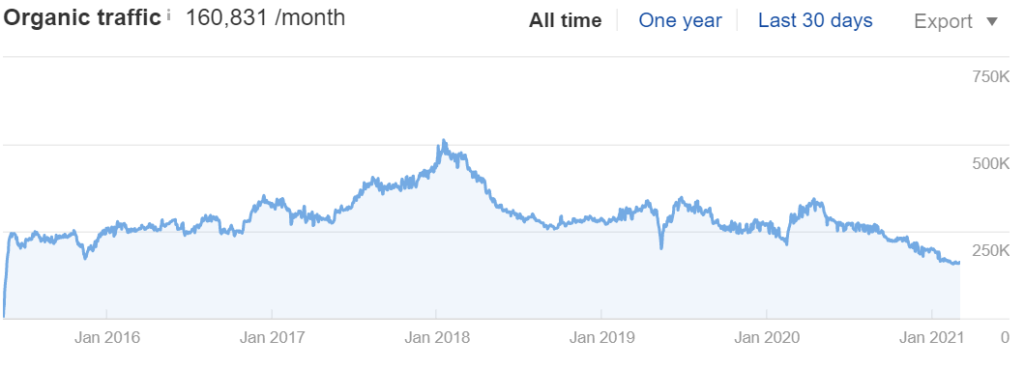
Their traffic has been up and down (which is normal), reaching a high of 500,000 visits at the beginning of 2018. Still, it’s been a consistently strong source of traffic for them.
Of that estimated 161,000 monthly organic visitors, only about 17,000 is branded traffic (coming from the homepage and the Joule page).

… which means Chef Steps enjoys roughly 144,000 non-branded organic visits per month.
Where’s it come from?
It comes from the same place as most great non-branded traffic: content, content, content.
Check out a few of their top pages (the left column is estimated traffic, the right-most column is the top keyword for that page).

A huge chunk of ChefSteps’ traffic comes from content in their /activity/ subfolder, which is really just a blog with recipes and cooking techniques.
It’s not products. It’s not about their brand.
Instead, it’s content created for an audience of potential customers: people who love cooking.
Like this article: “How to Truss a Chicken the Traditional Way.”

This is an educational, how-to-type article. It’s not about their products, and it’s not built to sell — at least not directly. Instead, it’s built for traffic; or, perhaps more accurately, it’s built to build an audience.
Because ChefSteps understands something very important: if you write only about your products, you’re putting an artificial ceiling on organic growth.
They do write about their products, of course. Most often, they write about what their products do.
I.e. Their flagship product, Joule, is a kitchen application that helps you easily sous vide food. So they produce plenty of content about how to cook things using a sous vide method.
This article’s a good example: “Tender, Juicy Sous Vide Lamb Chops.”

This article is a recipe (a tried-and-true way to build audiences in any kind of food space). It’s educational, and the recipe seems tasty (at least to this over-confident amateur home cook). But it writes about what their product does.
Their total blog catalog, though, is a mix.
Some of it’s about sous vides, how to sous vide things, and sous vide recipes, but ChefSteps is also building a massive audience by expanding its scope to people interested in cooking techniques, writing about broader topics (but topics their target audience may be looking for) and then getting those people on an email list.
How’s it working for them?
We can’t know for sure, of course, but they do give us some numbers at the very top of every one of those pages: it’s an invitation to join their massive email list (apparently it has almost 1.5M subscribers).

- 3 products
- 144,000 non-branded organic traffic
- And an email list with 1.M subscribers
Not bad.
But food is “easy,” right? Just blog about recipes. Who can’t do that?
What if you have a more difficult product, though…
What if your product is about… poop?
Example #2: Hello Tushy
- Products: 10
- Total organic traffic: 144,000
- Non-branded organic traffic: ~150,000/mo
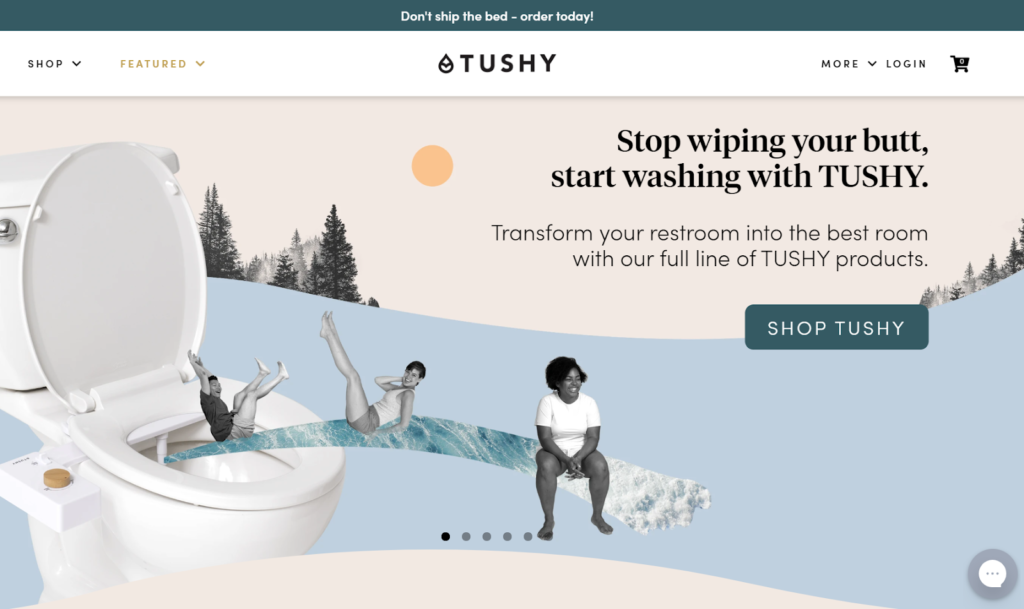
Hello Tushy may be one of my favorite companies out there right now.
They have about 10 products:
- The Tushy Classic 3.0, a bidet and their flagship product
- And a suite of other accessory products, including bamboo towels, bamboo toilet paper, and a toilet ottoman
Aside from being a total bidet convert (that might be TMI, but trust me: if you’re not on the bandwagon, you should be), I like Hello Tushy because they’re fantastic marketers.
They have a fantastic social media presence. Their paid teams smash it. And they have stellar branding. They “get it,” as they say.
In addition to all that, they have very, very strong organic traffic.
In total, Hello Tushy generates an estimated 272,000 organic visits per month.
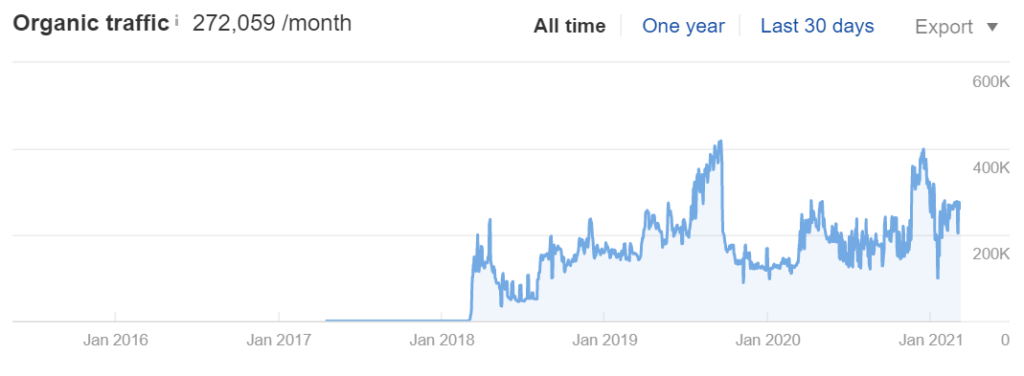
Like most brands that have been around for a while, their traffic has seen its share of ebbs and flows, but for the most part, their organic web presence has been strong from the beginning, peaking, in places, close to half a million visitors per month.
Of that traffic, about 20,000-30,000 monthly visits come from pages for which the primary keyword is unbranded.
That may be a bit smaller than ChefSteps, but consider that a similar brand in this space, the ultra-popular Squatty Potty, only has 42,000 visits total.
In other words, Hello Tushy’s traffic is very, very strong.
In addition to that, because of consistent (and, as far as I can tell, increasing) investment in organic traffic, their keyword graph (how many keywords they are showing up for in Google overall) is on a serious hockey stick.
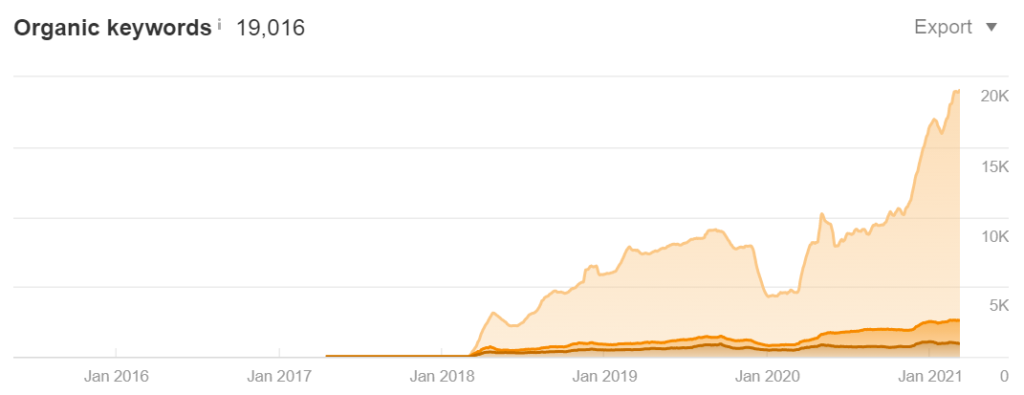
And when you consider that the shape of keyword graphs often precedes the shape of the traffic graph …
…yea; Hello Tushy is probably going to have a good year.
Outside of their comparatively small product catalog, the Hello Tushy team is producing content like this to generate traffic:
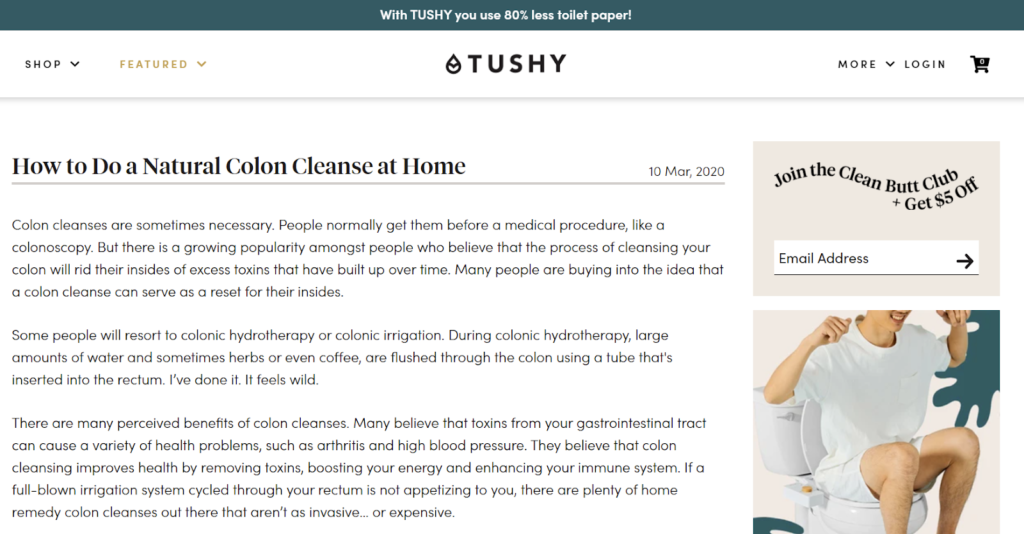
That blog post (“How to Do a Natural Colon Cleanse at Home”) generates about 1,000 eyeballs per month — 1,000 people who want to be better poopers, which is exactly Hello Tushy’s audience.
And this article, “How to Poo Properly: Best Position to Poop In According to Science,” brings in ~500 visits per month.
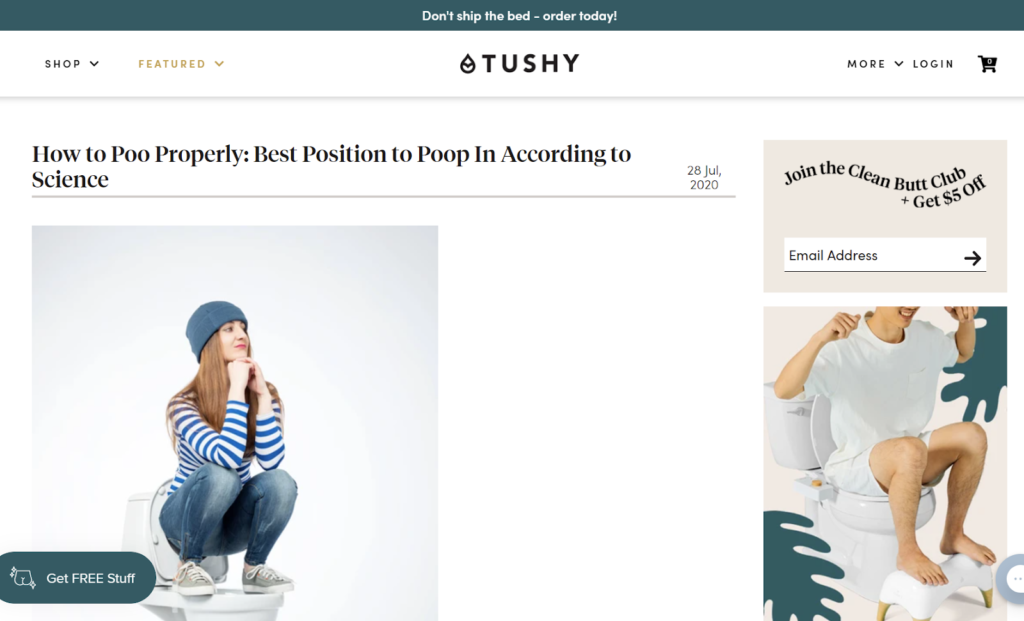
Same idea here: content about pooping, for poopers.
Their blog is full of this stuff.
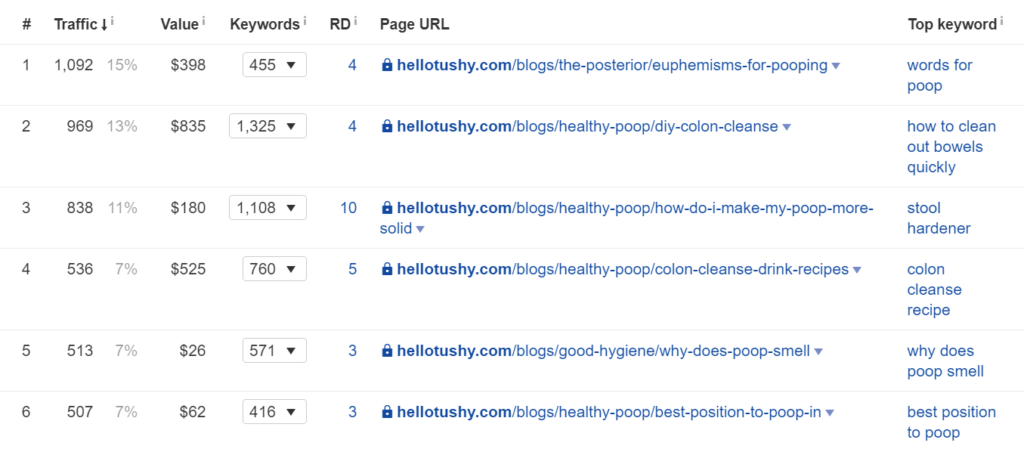
They’ve built a catalog of poop-related content that is bringing in loads (pun intended) of traffic.
Not only that, but their blog section is experiencing some pretty crazy growth. Check out the keyword graph (this is just for their blog).
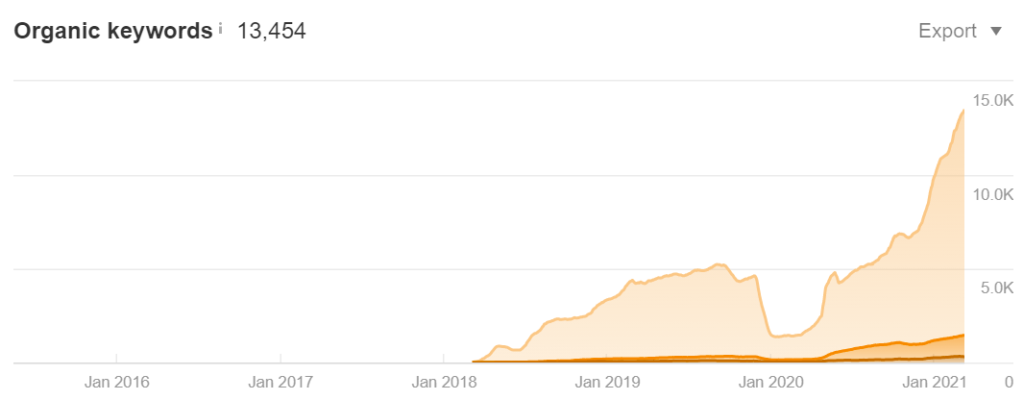
They are getting after it, and they are really leaning into the power of blogging to build a strong, active audience over time.
In addition to blogging, however, Hello Tushy understands the impact good branding can have on SEO.
In general, branded keywords are among the best keywords to have and to rank for because: (1) they tend to be very low-competition, and (2) it’s generally very difficult to displace you from the SERPs for branded keywords.
Of course, developing a strong, popular brand time is tough. But if you can get to a place where people are typing your name into Google, the results can be astounding.
Tushy knows this.
Of the keywords they show up for in Google, almost 500 (U.S. keywords) include their brand.

And because Hello Tushy has created brand equity, they can create pages that rank for branded keywords.
Like this one:

This is a page targeting the keyword “hello tushy reviews,” a keyword that 800 people search for every month. That’s a very, very good keyword to rank for — it’s 800 people who are interested enough in their product that they are seeking out reviews.
These people are very close to buying.
Hello Tushy knows that there will be other websites out there potentially trying to rank for that keyword (with pages that may potentially post negative reviews), so in order to be in that conversation, they created a page of their own that targets a keyword for reviews for their own product.
Just like the PPC team bids on their own brand, the SEO team is competing for branded keywords in the organic results.
That page comes up in position #4 (as of the time of this writing), and generates an estimated 750 organic visits per month. It’s a smart, smart play.
In other words, Hello Tushy is crushing it in Google, and they are doing all of this despite having only 10 products.
Example #3: Our own client (a keto store)
- Products: 6
- Non-branded organic traffic: ~30,000/mo
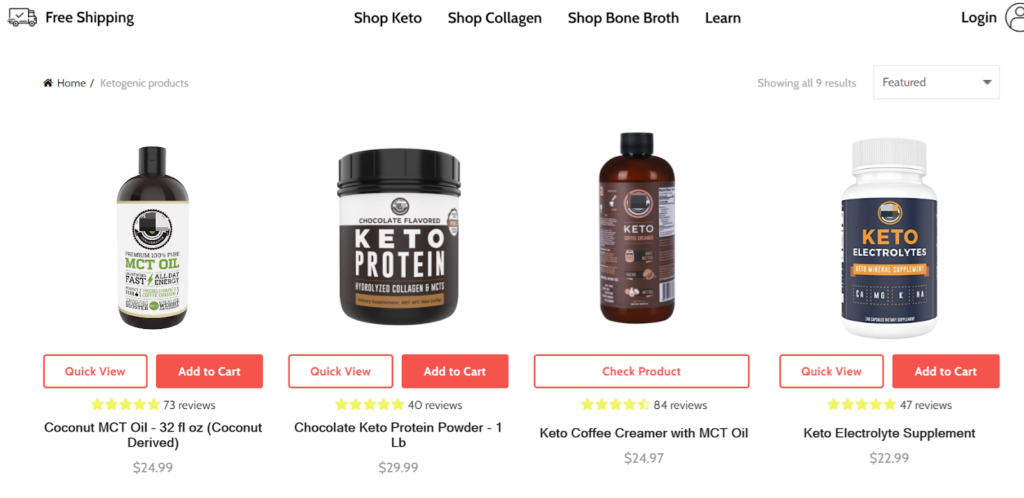
This is a client of ours.
Long story short, this client was a brand that sold keto supplements on Amazon (using Amazon’s FBA program). They were tired of relying solely on Amazon for sales and customer acquisition.
They wanted to own the media.
So, they started a website, and they tagged us to build and execute a strategy to develop an audience over time.
The tough part (which shouldn’t be a surprise considering the article you’re reading) was: they only had 6 products.
They were highly focused on a few key products, and that’s what their brand was. They didn’t plan on building a massive catalog. They were going to sell what they had and push hard to do it.
So what did we do?
We developed a strategy that leaned on the thing most successful “small” stores leverage if they want to win in Google: content, content, content.
For this client, that meant writing tons and tons of content about keto-related topics — answering as many questions as we could for people who had questions about keto.
Sometimes they were simple, like a guide on how to eat keto at Buffalo Wild Wings.

This was one of the most successful articles we produced, in fact, and it still generates almost 1,000 visits/mo.
And sometimes, the content was much more complex.
One of the first things we wrote, for example, was a complete guide to eating keto — everything from the basics to the science to tactical, day-to-day logistics.
We called it “Keto 101: The Ultimate Guide to Eating Keto.”

But the strategy was pretty simple: if we don’t have many products, we have to build our audience by answering their questions.
In total, over the course of a 6-month campaign, we wrote ~60,000 words on the keto diet. We were also able to build an audience of 20,000-30,000 monthly organic visitors and create traffic curves we were really proud of, like this:

This company now has an asset that generates sales for them outside of Amazon, which is a massive advantage.
And it’s especially important because the Amazon FBA space is increasingly filled with stories like this:

In short, for Amazon sellers, especially big ones who move lots of volume but don’t have many products, owning your own media can be a game-changer.
And for our client, it was.
How to do it
Okay — we can see it’s possible.
Stores with small catalogs absolutely can — and do — build large, defensible audiences on Google.
But how? How exactly?
In my view, if you’ve got fewer than 10 products and you want to crush it in Google, the thing you should be prepared to do is: invest in content.
With few products, the only way to give yourself the chance to rank for new keywords is to find them and produce new content that targets them.
In other words, you’ve got to blog.
And there are really two kinds to focus on — two kinds of content that show up over and over again in every example of a successful “small” store we see:
- Branded blogging
- Problem/question-based blogging
The strategy for those two can be significantly different. And sometimes — depending on your niche, the stage of your business, and your market’s competitive landscape — one may be much more difficult than the other.
So let’s take a look at what each of these might look like.
Branded blogging (…and not just your own brand)
Branded blogging = blogging about topics that include a brand.
Taking the example from above, Hello Tushy was doing branded blogging when they created a page targeting this keyword:
- “hello tushy reviews”
It’s a page targeting a keyword that includes their brand.
Real quick, though (because I know what a lot of you guys are thinking), I want to get something very important out of the way.
Being able to blog about your own brand is a luxury.
Building a brand takes a lot of time. And it especially takes a lot of time to build a brand big enough that people are typing it into Google.
However, I am not saying that in order for a “small” store to be successful in Google, it’s got to first build a brand.
That’s not true.
It’s nice. It helps. But there are other ways to tackle branded blogging even if you don’t yet have an established brand.
Namely, you can target other brands.
Let’s look at both of those: (1) blogging about your own brand and (2) blogging about other brands.
Blogging about your own brand
A lot of the time, your branded traffic is going to go right to your homepage (these will be people searching your brand only) or to a specific product (people searching for that product specifically).
In the SEO industry, these are what we call navigational keywords. People are typing these into Google mostly as a way to easily navigate to your website (or a product on your website).
These are NOT what we need to blog about.
Here’s an example from SimpliSafe (another “small” but highly successful eCommerce store).
Here’s keyword data for the keyword “simplisafe smart lock.”
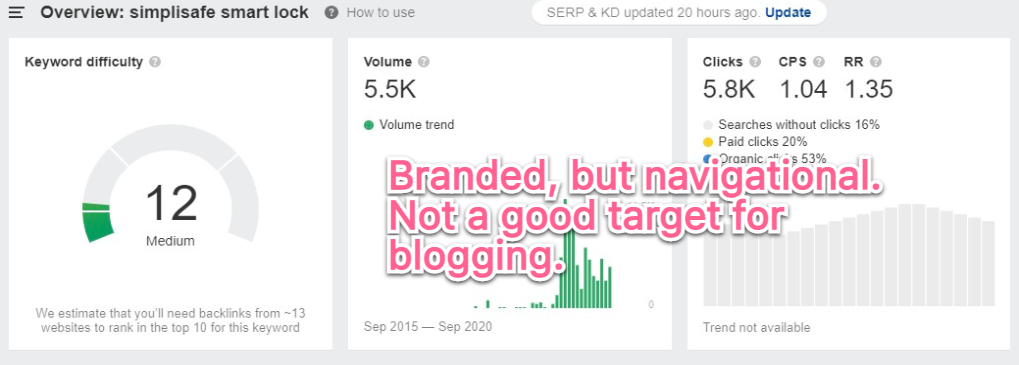
The numbers may look good here. There are 5,500 people typing this into Google monthly, and there’s not much competition.
But people typing this into Google are mostly looking for this product; there’s no real indicator that they’re looking to have a conversation or find out more information
For this kind of keyword, our product page can more or less stand on its own. Likewise with keywords like:
- “simplisafe”
- “simplisafe security system”
- “simplisafe camera”
- Etc.
These are all mostly navigational keywords for people hunting for our products already.
So what do we need to target when we set out to blog about our brand? Conversational keywords — keywords that indicate the searcher is both looking for your brand and wondering about something.
In other words, we want to look for keywords that meet the following criteria:
- Include your brand name
- Include some indicator of conversation
- Have a decent number of people searching for them each month
If we look at all keywords containing the word “simplisafe,” I’d pick out stuff like the following if I was going to launch a branded blogging campaign.

These are just two keywords out of a list of thousands that include the brand “simplisafe.”
But keywords like these indicate an opportunity to educate someone about your brand as they are looking and comparing your products to other products.
The keyword “simplisafe reviews,” for example, indicates someone who is looking specifically for SimpliSafe products but who wants to read reviews.
If I were SimpliSafe, I would absolutely want to be the one leading that conversation.
The other keyword, “ring vs simplisafe,” is a keyword that indicates users are searching for information about how SimpliSafe compares to one of its primary competitors.
Again, if I were SimpliSafe, I would absolutely want to be the one leading that conversation.
And how do we do that?
By writing blog posts (or, in some cases, producing landing pages) targeting those keywords.
Blogging about competitor’s brands
But what if we don’t have a big brand?
Lots of businesses don’t. Even high-revenue shops often don’t have a whole lot of brand equity.
If that’s you — if you’re an eCommerce store with a small brand and a small product catalog, can you still leverage the power of branded blogging?
Absolutely.
How? By writing about other brands.
This tactic isn’t necessarily for the faint of heart. It can definitely rub your competitors the wrong way, and if you’re like me, and you’re the kind of person who prefers to build a network of friends in your industry rather than the alternative, this may be one you skip.
That said, it’s a tactic employed by lots of powerful brands who are happy to take part in a little friendly competition.
Here’s the basic strategy: produce content that targets branded, conversational keywords about your competitors.
In particular, you could target keywords that indicate people are not happy with your competitors.
Here’s a good example.
This blog post is from a company called Monster VOIP, a company that offers phone and team communication services for small businesses.
They have some brand equity, but not a ton.
So, one of their strategies is to write articles that target keywords about their competitive brands, especially those that indicate their competitor’s customers may be looking for something different.
Like this one.

This targets the keyword “google voice alternative.”
And it’s a super solid keyword.

The keyword difficulty is a bit high, but 2,100 people search for it every month, and because they are actively looking for an alternative to a solution they’ve already spent money on, these people are likely very motivated to buy.
So Monster VOIP wrote an article on it.
It now ranks #4 in organic results and generates an estimated 844 visits per month.
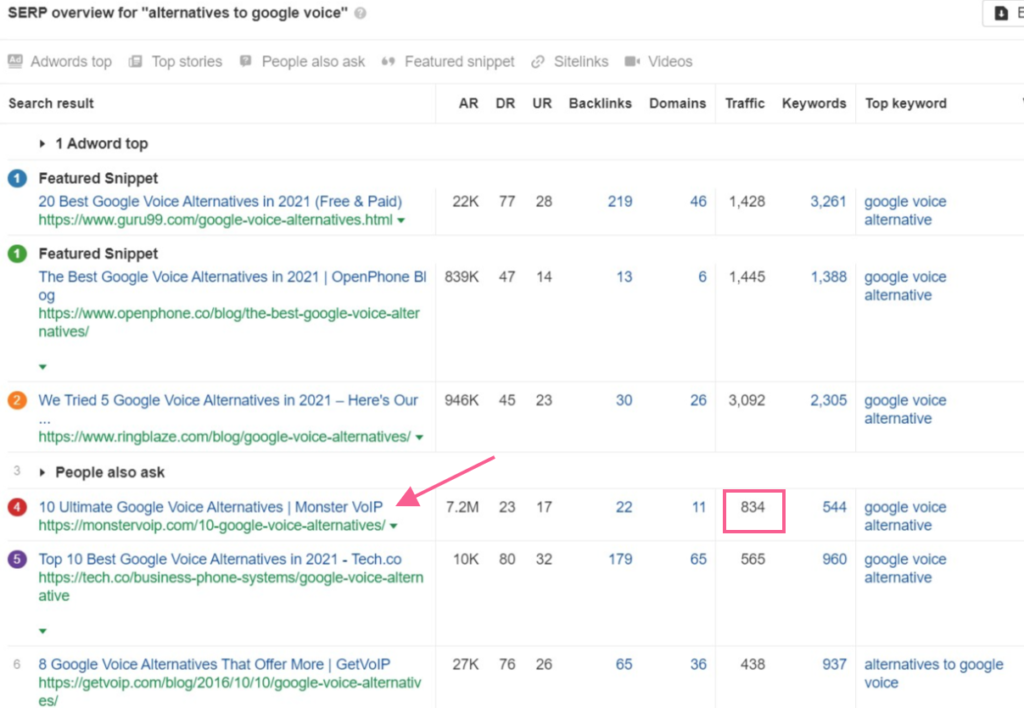
And this is one keyword about one competitor.
This strategy can be leveraged for any keyword that indicates people are asking questions (or, ideally, aren’t happy) with your competitors.
Branded blogging is great.
Branded blogging is powerful. They tend to be easier to rank for and are associated with strong buying intent.
But there’s generally a ceiling because there are usually exponentially fewer branded keywords floating around out there than other kinds of keywords.
So the audience is small.
What if we want to build a huge audience of buyers over time?
That’s where audience-oriented blogging comes in.
Audience-oriented blogging
In my view, audience-based blogging is one of the best — and one of the most overlooked — tactics any eCommerce business can use.
And it’s even more crucial (and often even more overlooked) by stores with small catalogs.
Audience-based blogging = producing content around highly specific topics your audience is already searching for to build a large, strong, defensible audience over time.
There are lots of ways to do this, but here are a few of the best.
1. Answer questions about your product verticals.
Imagine you’re Hello Tushy, and you’re just starting out. You’re selling a bidet. Bidets, to some people, can be… well… scary.
It’s a new sensation. It’s a different cleaning method. It can be expensive. And so on.
People will have questions. Someone somewhere has to answer them.
And if you can be the one who answers, it helps establish authority, expertise, and trust — and those things can lead to a sale.
And just look at all these questions people have about bidets:
Here’s keyword data for “how to use a bidet.”
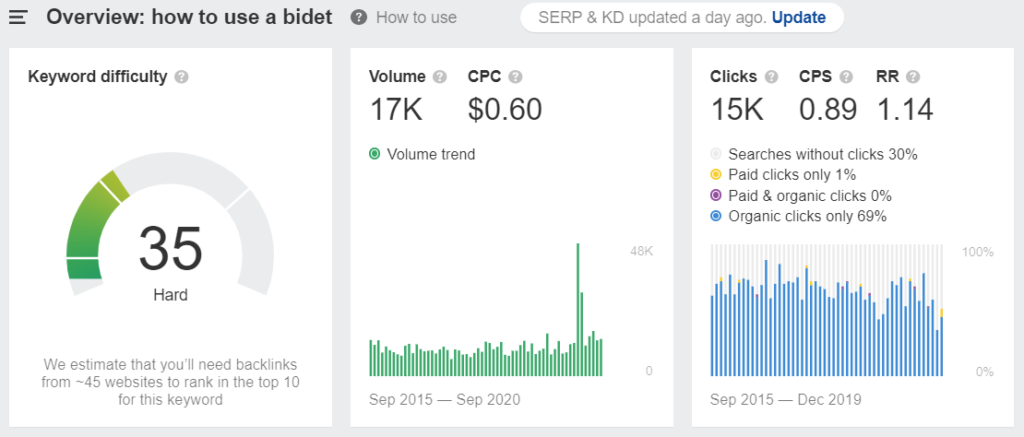
It’s slightly more competitive, but a company with a website as strong as Hello Tushy’s could certainly compete for it.
Here’s the data for “how to install a bidet.”

Slightly less volume here, but very, very low difficulty. It’s also a bit closer to the top of the funnel than the bottom, but of those 700 people, some are probably looking to buy and are curious about the level of expertise required to get the thing set up if they take the plunge. It’s a good conversation to be leading, and it’s a great stepping stone to incrementally build that audience.
This keyword would be cake for Hello Tushy.
And I especially like keywords like this one: “how much does a bidet cost.”
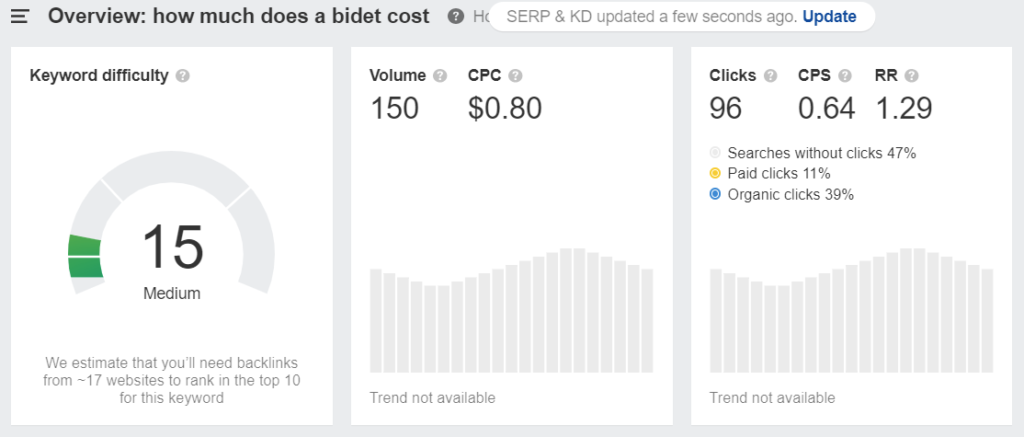
Someone searching for this keyword almost has their credit card out. People who have moved on from basic questions to ask about price are people who are interested.
These are people we’d want to talk to.
2. Talk to your target audience about their problems (even if they’re not specifically about your products).
Whoever your target audience is, they have problems.
Suppose you were an electric bike company. Your potential customers may have problems like the following:
- Bikes can be unsafe
- People steal bikes
- Bike laws change from state to state
- Commuting to work is annoying in big cities
- Being sweaty after cycling to work
- And so on
One of the ways you can attract potential customers is to demonstrate your expertise by helping them solve their problems — and then/also by offering your product as part of that solution.
This is true even if a keyword doesn’t necessarily indicate interest in your specific product.
Take this keyword: “bike theft prevention.”

This keyword is small but mighty.
It’d be relatively easy to rank for, and it helps our target audience solve a very specific problem.
It’s definitely near the top of the funnel, but it also attracts people who may be frustrated with bike theft.
If we owned an electric bike company, we could help educate them about bike theft, and we could add, “You know; with an electric bike, you need a key, making them much more difficult to steal.”
Then we’d point them to our products.
Or, we’d offer a bike safety checklist in exchange for their email address.
Anything.
But the point is; producing content about this stuff helps us help our target audience, and when we do that, over time, we make more sales.
This tactic is especially effective for problem-based products.
Think: SimpliSafe.
SimpliSafe is not a “fun” product (no offense, SimpliSafe, if, for some reason, you happen to be reading this).
It solves a problem. It solves the problem of home security.
And if I were SimpliSafe, I’d be blogging about that problem (and related problems) all day.
3. Talk to your target audience about their passions.
It’s also true that whoever your audience is, they’re interested in stuff.
They’ve got passions. They’re thinking and reading about things related to the thing you sell — that’s why people like them are buying from you, right?
So, one way to bring our target audience in is to create content about their passions.
And the idea is the same: we’re not necessarily looking to target the most specific customer. We’re not only writing about our products.
Instead, we’re trying to build a large, sustainable audience by talking to our customers about their passions.
One company that does this really well is the breakout Shopify star of 2021: Beard Brand.
Beard brand isn’t strictly a small store. But they’re small-ish. They have a couple dozen products.
But they’re certainly not large.
And they do an absolutely fantastic job blogging toward their customers’ passions.
The following screenshot is the estimated traffic only for their blog.
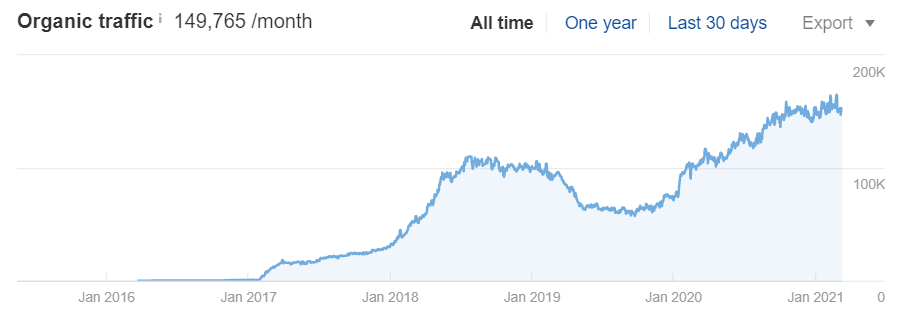
And this is their total traffic…

In other words, of their ~189,000 total monthly traffic, about 150,000 comes from their blog.
Beard Brand gets it. In a big way.
What kind of stuff do they write about? They write toward the passion of their customers.
It’s stuff like: “The 21 Best Beard Styles of 2021.”

And, “All Stages of Beard Growth Clarified: The Ultimate Timeline.”

And tons and tons of other articles.
They’re about beards and men’s style and grooming. And they’re fun to read.
Yes, Beard Brand very much understands the power of blogging toward your customer’s passions.
The result is a growing brand that was generating over $1M/yr in revenue in 2019 and showed no signs of slowing.
The “small store advantage”: why SEO sometimes works even better for stores with small catalogs…
As a final note, I wanted to say that, anecdotally, from running organic traffic campaigns for several businesses with small stores…
Sometimes, this stuff can work even better if you don’t have many products.
Why?
Because all the rest of your marketing can be so focused.
All the message goes to your one product. Every single page can nudge people to the same product. If you get people on an email list, you can promote your special thing.
There will never be any doubt about who you are and what you’re good at. If you only sell a few specific products — and you’re willing to invest in building a targeted audience of people around that product — the upside can be big.
